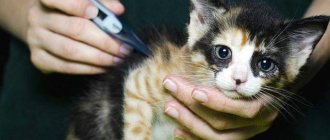Cat's well-being and behavior
After sterilization, the animal's condition will change every day. If you answer the question: how many days does a cat get sick after sterilization, then the average recovery process lasts a week. It is worth examining this issue in more detail.
First day
During the first 24 hours, the kitten will hardly eat. The animal will continue to recover from anesthesia. The state will be lethargic, drowsy, and coordination of movements will be impaired. Some pets begin to suffer from hallucinations.
The latter can be noticed if the operated patient suddenly gets up and runs or crawls to an unknown location. She may crash into a wall, fall, or fall asleep. Such reactions are considered completely normal, so owners should not worry.
Sometimes females cannot blink. Then you should help her by closing her eyes until the cat herself can reproduce a similar action. If you do not help her, there will be a risk of the cornea drying out and eye problems will begin.
Another common consequence of sterilization on the first day is involuntary urination and vomiting. Owners are advised to be close to the animal to prevent possible injuries or to promptly remove a damaged diaper or cloth. In this case, you cannot feed the animal. Water should be given using a pipette or syringe.
The first day becomes a difficult test for all owners of furry happiness, and therefore everyone asks the question even before the operation: “How long does a cat get sick after sterilization?».
Second day
On the second day, the furry miracle will feel better, and the pet’s behavior will be adequate. Owners should monitor the cat more closely: it will have a desire to hide from others in a hard-to-reach place.
As the cat begins to regain its strength, it may bite someone who wants to touch it if it feels pain or discomfort.
Additionally, it is worth noting such behavioral signs as:
- Licking the incision area;
- An excited reaction to extraneous sounds.
On the second day, it is allowed to feed the ward with small portions of food and often give water.
The third day
Already on the third day the cat will fully recover, and this will be proven by the following signs:
- The dream pet will be active. He will become interested in what is happening;
- The animal will begin to go to the tray or toilet on its own;
- Will demand food.
It is recommended to regularly check the female's body temperature. If the readings turn out to be low or high, you will need to immediately contact a veterinarian.
One of the reasons for possible complications lies in the effect of anesthesia on the animal’s body. For example, due to the fact that the painkiller slows down intestinal motility, the animal may have problems with bowel movements. Owners are advised to pay attention to this and help if necessary. This can be done by giving your pet a laxative.
Fourth day
The cat's condition improves and she begins to feed on her own. Urinary and excretory processes will improve. Anesthesia ceases to have a negative effect on the animal’s body.
Fifth day
On the fifth day, regeneration of the cut will begin. The swelling around the area where the stitch was made will gradually subside and scarring will begin. The cat is no longer sick. She runs around the apartment or house, jumping on low surfaces.
Last two days of the week
By the end of the week, the pet's strength finally returns. The scar gradually heals, the kitten becomes quite active, and an appetite begins to appear. It is also worth noting that the pain experienced by the pet in the first three days disappears.
Positive and negative sides
Any operation has its advantages and disadvantages. Therefore, it is necessary to evaluate everything correctly and weigh all the risks. Individual intolerance to anesthesia and complications in the postoperative period may occur.
Unnaturalness
Is it possible to spay a cat during heat?
Most opponents of sterilization emphasize that the reproductive instinct is natural, so you should not interfere with it. In fact, domestic animals have long been adapted to other living conditions.
Important! In nature and on the streets, cats live a maximum of 4-5 years.
No one needs a large number of kittens; it is very difficult to find so many owners for them. Even purebred babies from a “British” or Persian cat do not always find owners.
Therefore, sterilization is a reasonable way to control the number of individuals.
After the operation the animal is sick
Many factors affect the well-being of a pet: lack of stress, proper nutrition, heredity, etc. The operation itself has been worked out and does not affect the condition of the animal. Its only goal is to stop reproductive function.
After sterilization, you need to properly care for your cat.
For your information! The recovery period takes a little time. In modern clinics, the intervention is carried out using the laparoscopic method, i.e., punctures. In this case, there are no large scars left.
Obesity
There is a myth that after surgery the animal becomes lazy and fat. In fact, during heat, the cat eats less, and she spends calories calling the cat.
After sterilization, the pet needs to be fed with special food, which has a balanced composition. You need to play with the animal and help increase its activity.
Obesity is not a mandatory sign of sterilization.
Painfulness of the operation
Some people believe that intervention brings suffering, so animals should not be tortured like that. The operation itself is performed under general anesthesia and during this time the cat simply sleeps. Subsequent recovery does not take much time.
It is enough to process the seams and put a special blanket on the cat. If the operation was done with punctures, healing occurs faster.
Minuses
Sterilization has not only advantages. Negative consequences include an unpredictable reaction to anesthesia. Therefore, a full examination is first carried out: an ultrasound of the heart, an in-person examination and a general blood test is taken.
Important! The examination is done at the request of the owner.
Not all owners know whether a cat should be allowed to give birth before sterilization. Such a requirement is a myth. If the animal has never given birth, then after the operation the risk of cancer becomes zero.
In rare cases, postoperative complications may occur. Therefore, veterinarians always advise the necessary care measures: treatment of the seam, what to do in case of inflammation, etc.
Sometimes owners delay the moment of surgery. In this case, the problem of sterilizing an old cat arises. At this age, animals endure surgical interventions more difficult, but gentle anesthesia has been developed for such individuals.
To prevent the seam from licking, a blanket is put on the cat.
What affects the cat's condition after surgery?
A week is an average indicator, and you should not rely only on it. Some pets have a hard time with any type of surgery, and some begin to run already on the second day.
Among the signs affecting the cat's condition are:
- Age. The older the animal, the more difficult it is for it to withstand the intervention of a surgeon;
- Type of procedure. For example, if the surgery is an emergency, recovery may take longer;
- Type of anesthesia. Some medications may make the kitten's condition worse.
Thus, when thinking about the question of how long a cat is sick after sterilization, it is worth taking into account the factors listed above and drawing a conclusion.
What is the purpose of sterilization for cats?
The term "sterilization" is not entirely accurate. Stopping the access of eggs to the uterus solves the problem by half. Yes, there will be no kittens, but the frantic meow will not go anywhere.
Therefore, males and females are castrated. That is, they are deprived of the ovaries and testes - organs that secrete sex hormones. In such a situation, the uterus becomes redundant and is also removed.
Is the animal in pain?
After the operation, the kitten will still be under anesthesia, so they will not feel any pain. They will most likely appear on the second day, and among the main signs of possible behavior are:
- Manifestation of aggression. The animal may attack when the owner tries to touch;
- Dilated pupils;
- Gaze directed at one point;
- Refusal to eat;
- Staying in one position for a long time.
To help the female cope with the condition, you can give her painkillers or give her an injection. Before using medications, you should consult your veterinarian about their possible use.
What symptoms indicate imminent death?
The signs of imminent death are similar to the symptoms of severe, rapidly progressing diseases. Therefore, in order to avoid mistakes, you need to urgently call a veterinarian at the RosVet VC to your home so that he can confirm/refute the alleged diagnosis.
You cannot draw conclusions on your own, but the extinction of the animal’s life will be indicated by:
- weakened pulse, below 140-122 beats/min, critically below 60 beats/min, which means death is near;
- heavy, rapid breathing - above the standard of 20-30 respiratory movements per minute. It should not be confused with increased frequency due to heat and stress. The symptom is associated with poor respiratory function and lack of oxygen;
- low body temperature (measured in the rectum), normally in a healthy cat it cannot be lower than 37.7 C. In a dying pet, the temperature drops to 35-32 C, the paw pads become cold to the touch;
- no appetite, refusal of food, water. A few days before death, the cat stops eating and drinking, this can be understood by untouched food, dry feces, dark urine;
- urination, defecation “under oneself”, if this is not associated with paralysis of the hind limbs and pelvis. The cat is so weak that she cannot reach the litter box;
- dull, matted, unkempt fur, an unpleasant odor occurs due to disruption of the functioning of all organs, intoxication, the animal stops caring for itself;
- cloudy eyes, pupils do not react to light, eyes are sunken - such detachment speaks of the excruciating pain that animals endure.
Cats change their habits before they die; they can be excessively affectionate towards their owner and literally demand attention. Sometimes, on the contrary, they hide or leave home to die alone.
Why does a cat have increased activity?
Due to individual characteristics, pets can recover almost immediately after surgery, showing their usual activity. It is worth noting that they do not feel any discomfort at all and continue to behave as before sterilization.
Unfortunately, such activity becomes a risk to the health of the animal. In addition, such behavior negatively affects his recovery.
Active cats can be aggressive. This is expressed in attempts to bite and scratch anyone who wants to touch them.
Veterinarians recommend:
- Limit the movement of the animal. This can be done with your own hands, creating artificial barriers, closing rooms;
- Ensure complete rest;
- Use sedatives by adding them to water and food.
It is better for owners to prepare for possible attacks of active behavior in advance. A suitable solution would be to create a cool and isolated place for the cat where it will be moved after surgery.
Alternative options
There is no complete replacement for sterilization. There are hormonal drugs that suppress estrus, but they have a temporary effect. Gradually, you will have to give the animal more tablets, and this will lead to the appearance of oncology.
Herbal sedatives like “Cat Bayun” also do not solve the problem. They only reduce aggressiveness and make estrus less pronounced. But the drug does not protect against pyometra and oncology.
An owner may be unsure whether a cat needs to give birth before being spayed or whether it can be operated upon as an adult. Such myths have no basis in reality.
The operation has been practiced for a long time and belongs to the rank and file. The postoperative period takes about two weeks, after which the owner needs to put the cat on a diet. In return, the pet will live for many years.
Is cat aggression fixable?
There are often cases when a kitten after surgery begins to snarl, yell, hiss, growl and rush at its owners. This means your pet is experiencing severe pain or nausea. The owners should take this point into account and do everything necessary to alleviate the condition of the ward.
The best solution would be to visit a veterinary clinic. The doctor will examine the female, identify the cause of the behavior, and prescribe appropriate treatment.
It is worth additionally noting that pets may scream if the operation was not completed completely. The sound made does not mean aggression, but a desire to see and feel the cat nearby. To get rid of the screams, a second operation will be required.
What is sterilization?
Uninformed people believe that females are sterilized and males are castrated. In reality, both procedures apply to individuals of both sexes. Castration and sterilization are two completely different surgical interventions.
Sterilization - cutting or tying the spermatic cords in males, cutting out the uterus or tying the tubes in females. The purpose of the procedure is to make the animal unable to reproduce. In this case, the pet will not lose sexual activity.
Many veterinarians consider such an operation unfavorable, since an animal experiencing sexual desire, but not being able to reproduce, risks getting hormonal imbalance, ovarian cysts, and malignant tumors of the mammary glands.
Castration - cutting out the testicles in males and the uterus and appendages in females. After the procedure, the animal becomes not only sterile, but also sexually inactive.
During what period can an animal leave?
On average, the operation takes 40 minutes. The rest of the time is spent on restoring the pet. And if we talk about how long a cat will be sick after sterilization, then the period is determined based on the type of anesthesia.
The following are distinguished:
- Muscle relaxant and analgesic. A popular mixture used by most veterinarians. It is considered the most effective among those available, but the main disadvantage is the difficult recovery period. The animal may feel unwell throughout the day.
- Muscle relaxant and epudral anesthesia. Only experienced specialists are allowed to use this mixture. Any error in the pattern can lead to atrophy of the hind legs. The ability to move them will return, but for about two days the pet will move exclusively by crawling. If anesthesia is performed correctly, the body will recover within 8 hours, which is a plus.
- Gas and inhalation. High efficiency and minimal toxicity are the advantages of this option. When choosing this anesthesia, the owner does not have to worry about the pet’s condition, since he will come to his senses almost immediately after the operation is completed.
If you don't have surgery
Sterilization is not a mandatory procedure, and it is done only at the request of the owner. Sometimes a person does not plan to breed their cat with someone, but even the absence of pregnancy will lead to serious problems.
Is it possible to spay a pregnant cat early or late?
With constant estrus, the animal's strength is depleted, and the risk of purulent inflammation of the uterus increases. This condition often occurs with hidden symptoms. The cat may be a little lethargic, but the owner will not even attach any importance to this. There may be scanty discharge from the vagina.
Note! Surgery for pyometra is the only way to save the animal. But it is more difficult to tolerate, and the cat is more likely to die. In case of breast cancer, the tumor can be removed, but this is a temporary measure that will not provide a complete cure.
Therefore, every owner should think about their pet and make the right choice. Sterilization makes it possible to prolong a cat's life and improve its quality.
Caring for an animal after sterilization
Postoperative care for your cat requires careful attention. Sterilization is carried out under general anesthesia, which lowers the animal’s temperature. The place where the cat will lie should be placed on the floor, away from drafts and heating devices. After anesthesia, the animal's reflexes will be impaired , and it may fall from a chair or sofa. Cover the soft bedding with ironed cotton cloth. When your pet wakes up, you need to give her some water to wet her mouth.
The filler from the tray must be removed so that it does not get into the open wound. Instead, you can fill the tray with toilet paper or pharmacy diapers and change them regularly. To prevent the animal from licking and scratching the wound, you need to purchase a blanket made of light, breathable fabric. If the cat's persistence does not stop the blanket, you need to put a special plastic collar on the neck.
The seam must be inspected daily. Usually the wound heals quickly; after 10 to 12 days, the doctor will remove unnecessary staples or threads.
Brief description of the operation
To minimize possible complications, preparatory measures are recommended. They include not only actions immediately before surgery, but also ongoing disease prevention. In particular, this refers to annual vaccination.
Preparing the animal
Anesthesia weakens the immune system, increasing the risk of infection by harmful microorganisms and parasites. For safety, it is recommended to vaccinate your pet at least a month before the procedure. Treatment for helminths is carried out within 1.5-2 weeks. In the absence of timely vaccination, the cat is given a serum injection that stimulates a stable immune response for 2 weeks.
A few days before surgery, a urine and blood test is taken from the tailed patient. To determine the safe dosage of a narcotic substance, the functioning of the heart and respiratory organs is checked using ultrasound and x-rays.
It is recommended to give up feeding 12 hours before, and water 3 hours before. This eliminates the occurrence of vomiting, which provokes the development of aspiration pneumonia.
Choosing a clinic and veterinarian
Pets that don't go outside are afraid to leave their familiar territory. To minimize stress, it is better to choose a clinic closer to home. Walking distance will eliminate travel by transport, reducing the time you spend outside your usual conditions.
For especially timid pets, calling a veterinarian to your home is a good idea. This eliminates the stress caused by a change of environment and the risk of infection from other visitors. The disadvantage of home surgery is the low sterility and lack of equipment necessary to eliminate possible complications. Most clinics provide both types of services, so the choice is up to the owner.
It is ideal if you vaccinate your animal and take it for routine examinations to the same clinic and to the same doctor. A regular veterinarian is familiar with the characteristics of the body.
Progress of the procedure
After anesthesia is administered to the tailed patient, the hair is removed at the site of the future incision or puncture. The procedure itself is carried out in two ways:
- surgical, involving classical excision with a scalpel;
- laparoscopic, based on the creation of small punctures using endoscopic equipment.
In both cases, after making an incision, the surgeon removes the reproductive organs and applies stitches. They are removable and non-removable. The first ones are removed 7-10 days after the procedure, and the second ones resolve on their own.











